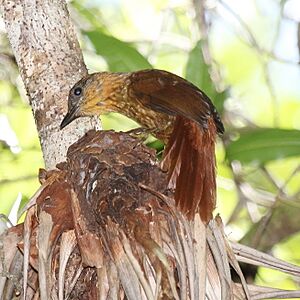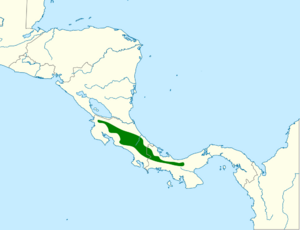Streak-breasted treehunter facts for kids
Quick facts for kids Streak-breasted treehunter |
|
|---|---|
 |
|
| Conservation status | |
| Scientific classification | |
| Genus: |
Thripadectes
|
| Species: |
rufobrunneus
|
 |
|
| Synonyms | |
|
|
The streak-breasted treehunter (Thripadectes rufobrunneus) is a cool bird that lives in the forests of Costa Rica and Panama. It's part of the ovenbird family called Furnariidae. These birds are known for building interesting nests. The streak-breasted treehunter is a passerine bird, which means it's a perching bird, like many songbirds you might know.
Contents
About the Streak-breasted Treehunter
Its Scientific Name
Scientists give every animal a special two-part name. This helps everyone around the world know exactly which animal they are talking about. The streak-breasted treehunter's scientific name is Thripadectes rufobrunneus. An American bird expert named George Newbold Lawrence first described this bird in 1865. He found a specimen near San José, Costa Rica. The name rufobrunneus means "brown" in a special kind of Latin.
What it Looks Like
The streak-breasted treehunter is a medium-sized bird, about 20 to 22 cm (7.9 to 8.7 in) long. That's about the length of a regular pencil. It weighs between 48 to 54 g (1.7 to 1.9 oz), which is about as much as a small candy bar.
This bird is mostly dark brown. It has a dark face with a hint of reddish-brown near its ears. Its crown, which is the top of its head, is blackish with long olive streaks. Its back and rump are a rich dark brown. The wings are also dark brown. Its tail is a rich chestnut-brown color.
The throat of the bird is a dull yellowish-brown. Its chest and belly are brown with thin yellowish-brown streaks. These streaks fade out towards its lower belly. Its eyes are dark brown. The bill is black, and its legs and feet are dark grayish-green. Young birds have lighter streaks on their chest than adult birds.
Where it Lives
The streak-breasted treehunter lives in the Talamancan montane forests in Costa Rica and Panama. These are mountain forests. It can be found as far south as Veraguas Province in Panama. It also lives in older secondary forest, which is forest that has grown back after being cut down.
This bird especially likes deep valleys with streams. It also likes areas with many epiphytes. Epiphytes are plants that grow on other plants, like mosses and ferns on trees. You can find this bird from 700 and 3,000 m (2,300 and 9,800 ft) above sea level. It is most common in Costa Rica between 1,200 and 2,500 m (3,900 and 8,200 ft) high.
How it Behaves
Movement
The streak-breasted treehunter stays in the same area all year round. It does not migrate to other places.
What it Eats
This bird eats mostly arthropods, which include insects and spiders. It also eats small vertebrates like frogs and salamanders. It usually forages alone, meaning it looks for food by itself. Sometimes, you might see a pair of them together. It rarely joins large groups of different bird species looking for food.
The streak-breasted treehunter finds its food in thick plants close to the ground. It hops and climbs among branches. It picks prey from dead leaves, moss, and other plant debris. It can even rip apart bunches of dead leaves to find hidden food. Sometimes, it hangs upside down to reach its meal!
Reproduction and Life Cycle
The breeding season for the streak-breasted treehunter is from February to August. This bird builds its nest by digging a tunnel in an earthen bank. The tunnel can be up to 70 cm (28 in) long. At the end of the tunnel, it makes a chamber. It lines this chamber with leaf stems and small roots.
A female bird usually lays two eggs. We don't know exactly how long it takes for the eggs to hatch or for the young birds to leave the nest. Both the male and female parents help feed the baby birds. The male bird has also been seen helping to incubate the eggs.
Its Sounds
The streak-breasted treehunter has a few different calls. One of its songs sounds like a scratchy "che-brah, che-brah, che-brah..." It can sound a bit like it's scolding you! Another song is a series of rolling, burry "chi-wówr" notes. Its regular calls include a harsh, grating "zeck" or "tseck," or sometimes "cheyt, cheyt." It can also make a doubled "rek-rek" sound.
Status and Conservation
The IUCN (International Union for Conservation of Nature) has listed the streak-breasted treehunter as a species of "Least Concern." This means that scientists believe it is not currently in danger of disappearing.
Even though it lives in a somewhat small area, its population is estimated to be between 20,000 and 50,000 adult birds. This number is thought to be stable, meaning it's not going down. There are no big threats to this bird right now. It is considered uncommon to fairly common in its habitat. It can even handle some areas where the forest has been broken up into smaller pieces.


